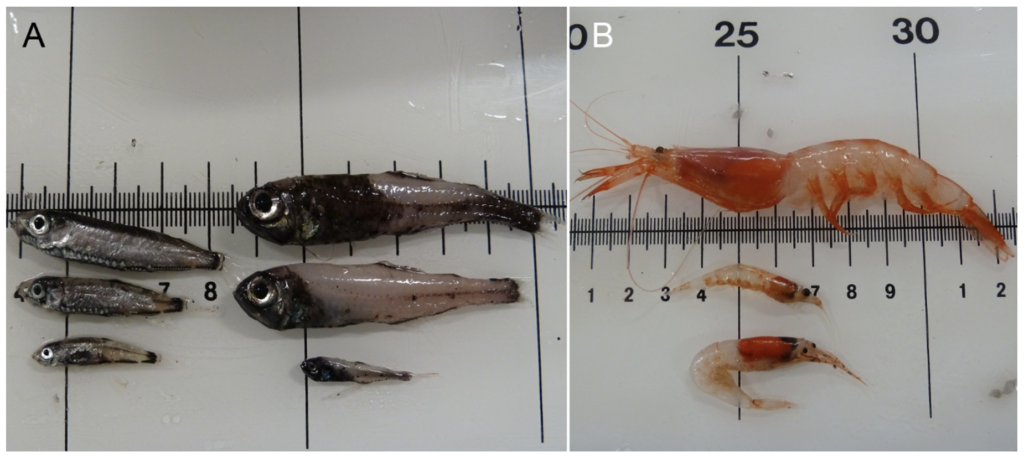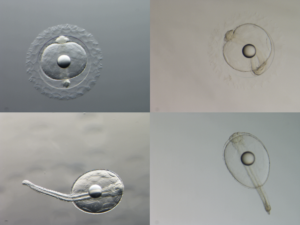By Anne Gro Salvanes // 9 April 2021
A short glimpse from fieldwork onboard a research ship
Our aim for the expedition was to collect samples and data that could help us answer the research questions of the HypOnFjordFish project. This includes collecting materials for the projects of our Postdoc researcher, PhD students and Master students. We had eight days of ship time available. We were nine participants to work and process all catches from pelagic trawls, traps, longline and to filter water samples day and night. To process a sample means to identify species composition of fish, crustaceans and jellyfish, weigh species groups and count individuals, measure length (or helmet diameter of the jelly), dissect out ear stones, check stomach contents and energy storage from all large fish and preserve samples from smaller organisms.
Various kinds of tissue samples were preserved from all species so that we can study in further details interactions between the different inhabitants of the fjord communities (who eats who and do they eat on the seabed, scavenge or in the pelagic). We also measured light, temperature, oxygen and salinity using sensors on an instrument called CTD, and we collected water samples that were filtered for light absorption measures, geochemical analyses, measures of oxygen contents to calibrate sensors, carbonate chemistry analyses, and for measuring POM (particulate organic matter). We also used large ocean-traps (havteiner) to catch bottom fish in fjords where bottom trawling was not possible, and vertically set longlines with fixed space between hooks (designed by Mette Hordnes) to study vertical migration patterns of bottom fish.
A research cruise & expedition needs planning
Originally, we planned to visit five fjords for eight days (Fig. 1). Yes, you are right in that this sound too ambitious. The research ship must travel between fjords, and maximum speed is 10 knots per hour (18.5 km/h), and all operations take time (e.g., to set and haul a trawl takes ca 2 h, depending on depth). Some fjords are 1-2 h apart, others 6-8 h. The wider group of HypOnFjordFish participants took part in initial planning, but only a core group participated in the work onboard. Our overseas project participants were hindered due to travel restrictions caused by the pandemic. Two participants worked with the details of the sampling plan and tried to meet most wishes from the wider group; one had prior experience and that the other was learning.
A PhD student and I spent days to try to find proper time distributions of acoustic transect over the trawl path before trawling, trawl settings, CTD casts, collecting water, measure light, setting long-line, hauling long-line, setting traps and hauling traps, in order to meet the wishes from the wider group. One time we believed we had reached the optimal solution, but we soon realized we were 1-2 days short… We had though a plan just before we went to sea, but we know from experience there will be plan A, B, C, D…. all depending on unexpected events that happens with the equipment or ship when we are out at sea. The first change in the cruise plan happened the day before we left harbour; we were told by a local fisherman that one of the fjords (Haugsværsfjorden) were frozen so the ship could not go into the fjord. The year 2021 was the coldest winter in 10 years in Western Norway. Too bad we could no go there, this little fjord is completely anoxic in its basin water. But we must wait and prioritize sampling that fjord as soon as it is possible.

The expedition 16-23 February
We took off onboard the research ship Kristine Bonnevie the morning of 16th February. Our Plan A started by visiting Osterfjorden and Sørfjorden, which are fjords close to Bergen. Here we wanted to test out if our favorite equipment worked properly before we went to the most distant fjords. One of our most important equipment is a MultiSampler. This is a large frame (1.2 x 1 m) fitted with 3 cod-ends and that is mended on a midwater trawl called Harstad-trawl (Fig. 2). The way we use it is to lower the trawl to the deepest depth, open the first cod-end and haul for 10-15 minutes before we close the first cod-end. We let then let all nets be closed for five minutes so that fish in front of the Multi-Sampler are flushed away before we open the second net on our next chosen start depth, and then follow the same procedure. The benefit of this equipment is to get three samples from different depth ranges in one trawl operation. This saves time and give depth-stratified samples.

We started with light measurements in the water column of Osterfjorden using a transmissiometer, when the crew on the ship fitted the MultiSampler to the pelagic trawl. In addition, we had three casts with the CTD, the instrument with several sensors and water bottles (Fig. 3). The sensors measure depth, temperature, oxygen, salinity. When the MultiSampler was mended on the trawl, we had our first trial, and this unfortunately failed. The electronics on it was tested and some units had to be replaced, before the equipment was ready for another trial. But it was too late in the day. We had lost time. The need for plan B! We had already collected lots of water samples from one fjord (Osterfjorden) and half of the samples had to be analyzed when fresh, and we needed the same from a second fjord (Sørfjorden), and the water samples were to be picked up by the Geophysical Institute the next morning. Plan B was then to go and collect these water samples and trawl afterwards. However, when those of us that had not filtered water from Sørfjorden woke up the next morning, the HypOnFjordFish expedition was interrupted with a quite serious event; a complicated engine failure that could not be repaired onboard. Kristine Bonnevie had to go back to Bergen to get engine repair! This means that plan C was needed before 24 h had passed! The engine was fixed, but it took much longer that we hoped. We lost 18 hours of our ships time. Plan C: go straight ahead to the more distant fjords (Masfjorden and Fensfjorden), 6 -8 h away from Bergen, before returning to the previous fjords and complete the trawl sampling there. However, the lost time meant also that we hat to revise the distribution and number of sample stations. Having the aim to collect all essential data and samples from fish, crustaceans and jellyfish from all fjord communities, we had to reduce the number of trawl replicates. This meant start all over again with planning….

Plan C started in Masfjorden the morning of 18th February – our MultiSampler worked perfect! However, other questions came up. The first day in Masfjorden we realized that it was impossible to do all measures, tissue samples, photos etc etc according to wishes from the wider HypOnFjordFish group. Many of the suggestions from the wider group had taken into account time, i.e. the amount of time each extra sample procedure from an extra individual will take when the samples are processed. When the time was summed up took longer to complete the processing than the total number of hours in a day. There was a need of reorientation and plan D! A meeting was needed. All cruise participants had a thorough discussion on:
*What can and must be prioritized (data for PhD and M Sci projects)
*What is possible to achieve within the time available.
*What do we sample onboard and what do we preserve for sampling back at the university.
The cruise participants agreed on Plan D which was made along with a processing list that needed to be strictly followed and ticked off so was possible to have overview of samples and collections preserved for future scrutiny.
How much and what did we catch?
together in all fjords we processed 34 cod-ends from the MultiSampler- and deep pelagic trawl hauls, catches from 10 long-line settings, two ocean-trap settings, filtered water from several depths from 12 CTD casts from surface to seabed. Each of the cod ends were fishing for 10-15 minutes. Total weight of all pelagic trawl organisms in all fjords was ca 3500 kg. Of these 81.6% consisted of helmet jellyfish Periphylla periphylla (Fig. 5), 12.9% of the lanternfish Benthosema glaciale, 0.6% of the pearlside Maurolicus muelleri, 0.6% of the shrimp Sergestes articus, and 0.2 % of krill Meganyctiphanes norvegica (Fig. 4). We length measured over 6500 fish individuals, and ca 300 large fish were sampled in detail or had to be frozen for future inspection if no time to process all.

The effort but also the catches were lower in the traps and long-lines (altogether ca 63 kg). The species caught were two shark species; the velvet belly (Etmopterus spinax; 32.6%), the blackmouth catshark (Galeus melastomus; 11.9%); the gadoids greater forkbeard (Phycis blennoides; 21%); tusk (Brosme brosme; 19.0%) and the roundnose grenadier (Coryphaenoides rupestris; 9.9%). The two shark species and the roundnose grenadier were also caught in the deepest pelagic trawl hauls that we made.
Size composition of the dominating pelagic and benthic species
Overall, the helmet jellyfish was present in all four fjords, but the size compositions differ between the fjords (Fig. 5).

The velvet belly was the dominating species of the catches from the seabed in Masfjorden and was also present in Fensfjorden (Fig. 6). The species was also caught in the deep pelagic trawl hauls.







